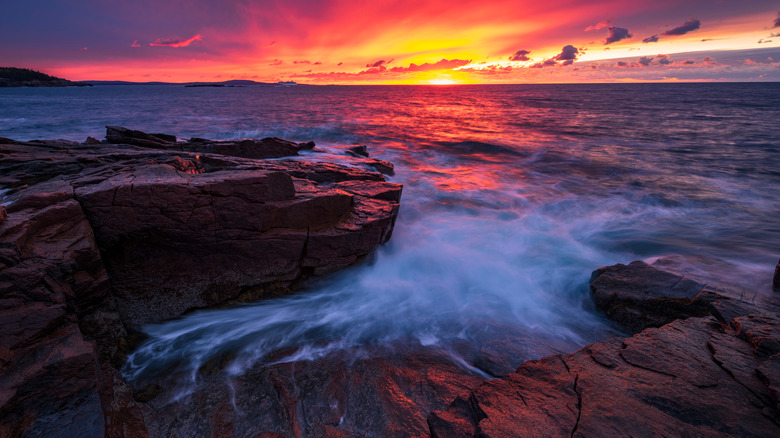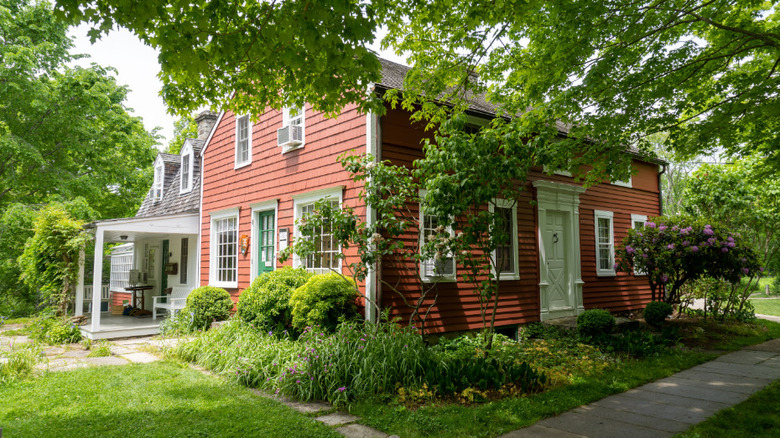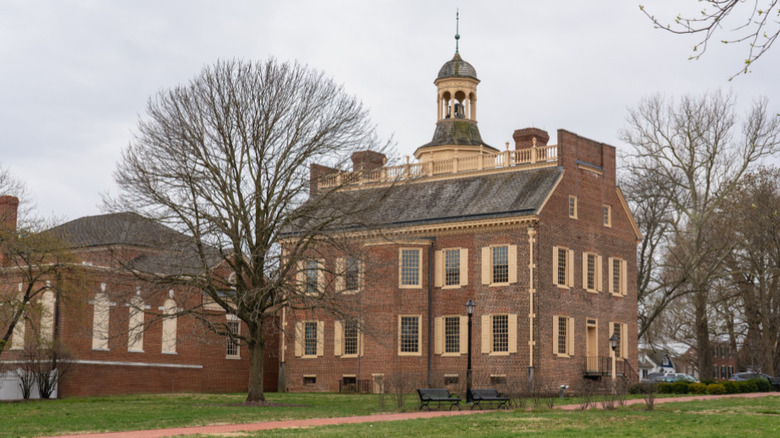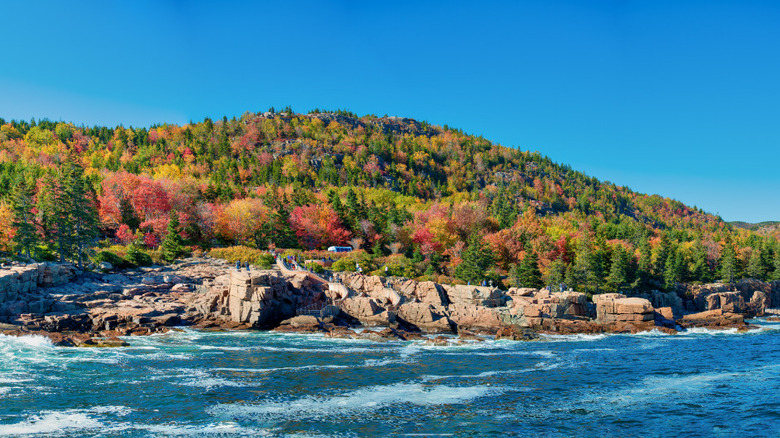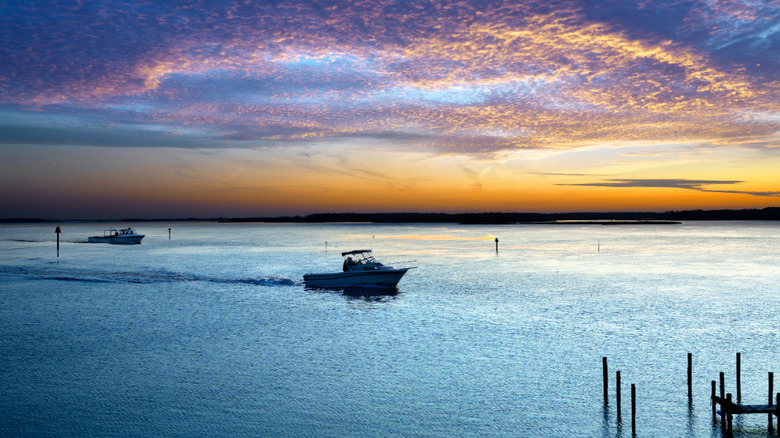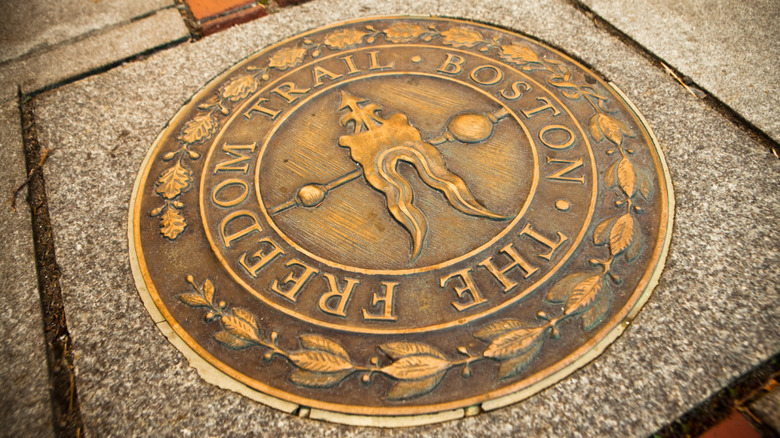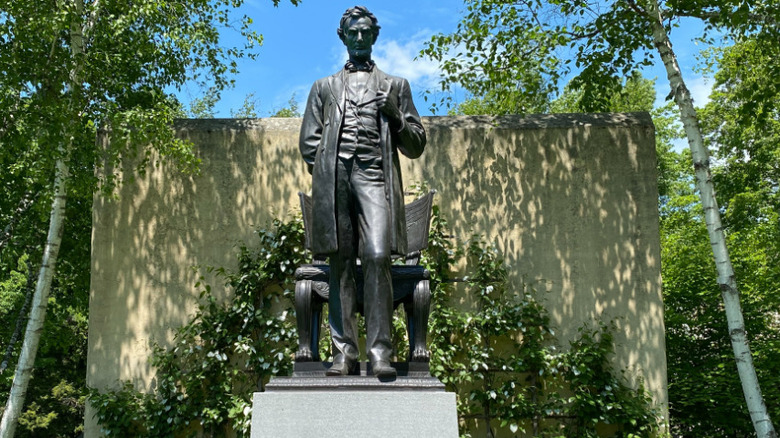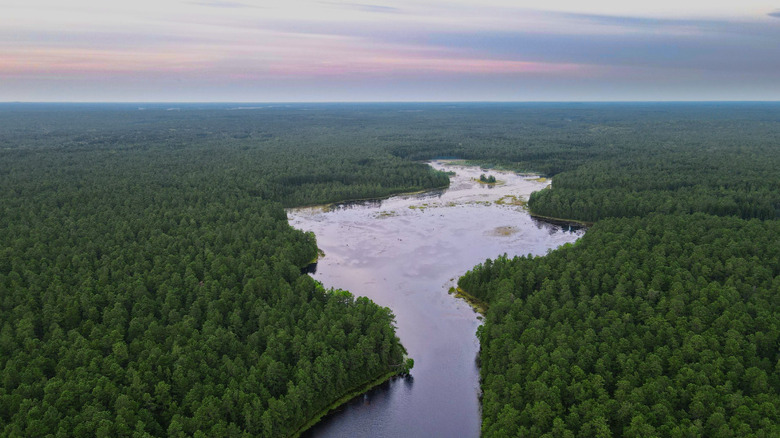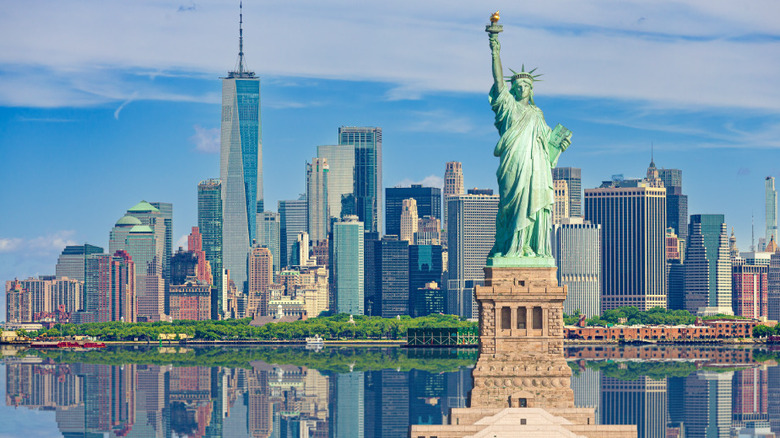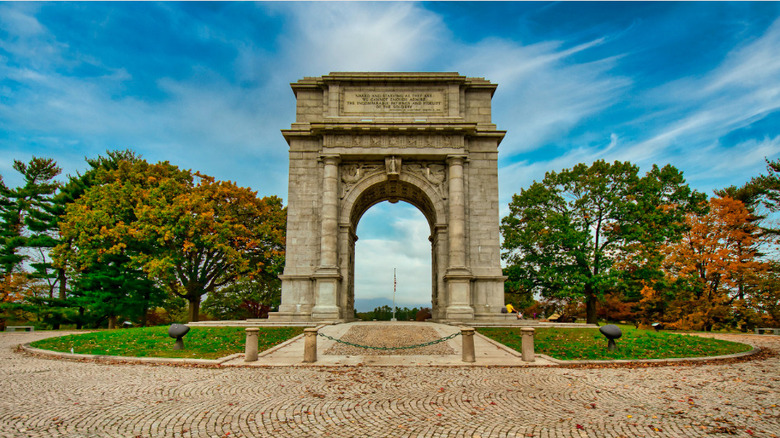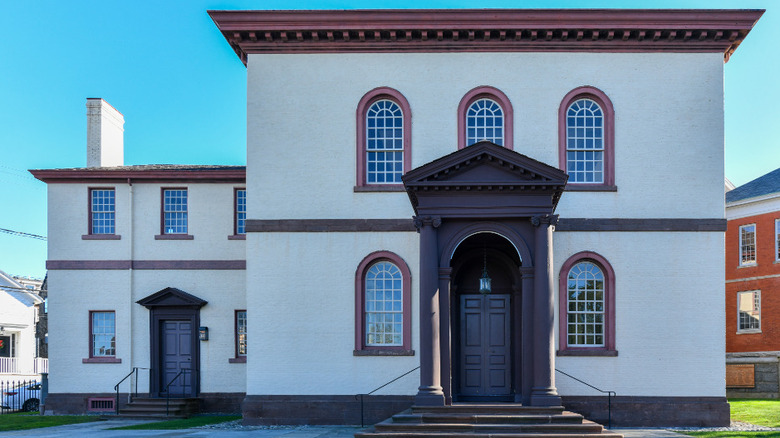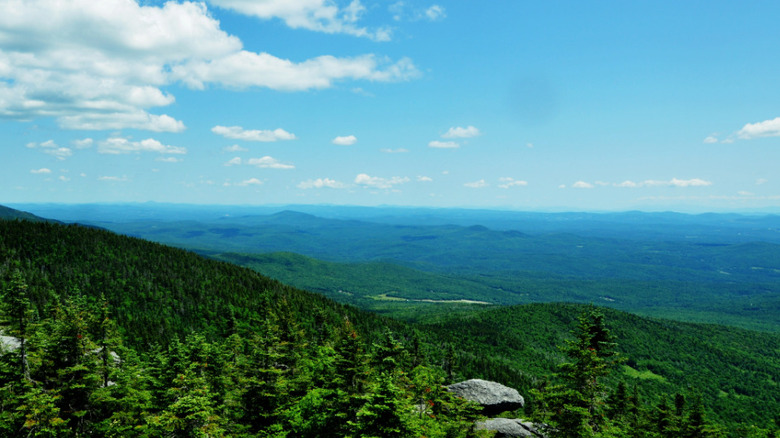Where To Find The Best National Parks On The East Coast
The West Coast may get a lot of attention for being the place to go for a glamorous vacation, but the East Coast is no ugly stepsister! From Appalachia to the gorgeous lands of New England, they've got it going on over in the East. Even more striking than its surface beauty, though, is the history that can be found in this region. Early American history is ingrained in pretty much every state on the East Coast, and the National Parks Service has preserved quite a bit of it right alongside the natural sites.
Sandy beaches, rocky shores, forested mountains, and historical cities are what awaits you when visiting the East Coast's national parks. Each state on this coast has something unique and special to offer visitors, and the very best national parks make for one educational and enlightening road trip for travelers who have some time to spare. Even if you're focusing on just one national park, here are some of the best found on the East Coast to choose from.
Connecticut's Weir Farm National Historical Park
While Connecticut doesn't have any official national parks, it is a state with a rich past and historical sites that are significant to the history of America. One such place is Weir Farm National Historical Park, where the life and works of early American artists can be seen and appreciated. The collection of family homes formed a kind of artist inspiration collective — it was to painters as Walden was to writers.
The park preserves the home and studio of its namesake artist, impressionist Julian Alden Weir, known to him as simply the "Great Good Place." Visitors can explore the home and studio, as well as the gardens, woodlands, and surrounding nature scenes that undoubtedly were the inspiration for a number of paintings and artists who have stepped foot and laid eyes on the property. Aspiring painters and wearied artists alike may come here to soak in that same inspirational atmosphere that has thrived here for hundreds of years.
Delaware's First State Historical Park
As the first official state in what would become the United States of America, Delaware holds a lot of significance to early American history. The entire state offers points of interest, a number of which are included in the First State Historical Park. Luckily, the small state is easily traversed and it only takes about two hours to travel the vertical length of the state, making the six historical sites spread across the state that are all part of First State Historical Park relatively easy to visit all in one day.
The important park sites include the Dover Green near the town's historic state house, which is the first-ever state park and heritage park. First State Historical Park also includes Brandywine Valley, which comprises 18 miles of wildlife trails and a famous creek of the same name, where a Revolutionary War battle was fought. Whether you're a history buff or just want to get a good picture of Delaware in its entirety, this park is a great choice for a day trip.
Maine's Acadia National Park
Maine is known for its rocky shorelines and wooded mainlands, both of which are on full display within Acadia National Park. The park also includes a number of coastal islands that are stunning from the mainland's coast and from close-up. Visiting Acadia anytime comes with the promise of stunning views, but Autumn is particularly awe-inspiring. With fall colors on full display, the many different views and scenes fill the eye with vibrance. As one of the very first places in the United States to see sunrise, watching the sun come up from the park is something extra special.
There are various places to explore within Acadia National Park, and pretty much all of them will come with views you can not believe. Isle au Haut, Baker Island, and the Schoodic Peninsula are all worth checking out if you want to stick with water views. Baker Island can only be seen with a guided boat tour, which may provide a nice break from trekking the rocky trails on foot.
Maryland's Chesapeake Bay Watershed
Okay, so it's not technically a national park — yet — but the Chesapeake Bay has been consistently the topic of conversation in giving it national park status, which it may end up receiving relatively soon. The country's largest estuary, the bay is home to a whole lot of wildlife, including endangered species. Overfishing and pollution in the water has caused the bay itself to become a little bit endangered too, which would be greatly remedied if it were to be under the protection of the National Parks Service.
Swimming, fishing, boating, and many other water activities are still available to those who want to take advantage of the Chesapeake Bay. Small communities can be found throughout the islands and peninsula, which all show various wildlife present. Wild horses can be found on Assateague Island, a surprising and welcome addition to the area and a sight you can see for yourself if walking the island's beach.
Massachusetts' Boston National Historical Park
Yes, the whole city of Boston is Massachusetts' best national park. You'd be hard pressed to find a city with as much American history as Boston. The Revolutionary War practically started in Boston, with the city's residents resisting their pushy British commanders. The Boston Tea Party and the Boston Massacre are both pivotal points in American history that took place here.
History buffs can follow the city's Freedom Trail, which is marked throughout the city and leads to all the significant sites that will remain in history. Visitors can walk along the trail while listening to the history of each site as they go, and digital audio tours are available for those who would like to explore the city via its historical significance but can't quite make it in person. The tour takes an hour and a half just in audio, so walking the trail will take quite a chunk of time — plenty worth it, though, for fans of history and knowledge.
New Hampshire's Saint-Gaudens National Historic Park
For travelers looking for a little less nature and a little more human-made inspiration, Cornish, New Hampshire's Saint-Gaudens National Historic Park may be just the destination for your next New England road trip.
This historic park sets aside the home and studio of bronze sculptor Augustus Saint-Gaudens. You'll see plenty of flowers in the garden and have fresh air to breathe here, but this national historic park is more about what people of all ages can create, and there are art programs and activities to help bring out the creativity in all.
New Jersey's New Jersey Pinelands National Reserve
New Jersey's Pinelands were the very first area to be established as a reserve and this critically important biosphere consists of a whopping million acres of land, making up around 22% of the entire state. Wetlands, farm land, forests, and communities are all found in the reserve. Visitors are welcome in the Pinelands and it is encouraged to spend a few days here to really soak in all the area has to offer and appreciate the ecoregion for the peaceful place it is.
New York's Statue of Liberty National Monument
Of course, you can't think of New York without having to acknowledge and celebrate Lady Liberty. The Statue of Liberty has become a defining image of New York and still stands as a promise that America will accept those who need it. We are stronger together, and the statue is one powerful statement and symbol of our melting pot status. If you are feeling particularly brave, taking a trip up the 162 steps to the statue's crown will give you such an amazing and jaw-dropping view of the surrounding city and harbor.
Pennsylvania's Valley Forge National Historic Park
Pennsylvania is one of the most history-rich states when it comes to Early American history, and right outside of the City of Brotherly Love sits Valley Forge, the site where Washington's army camped out the winter while the British held Philadelphia. The historic park allows visitors to tour the encampment either in person or digitally with an audio tour. For history buffs specifically interested in the Revolutionary War, Valley Forge is a vital stop, especially when just a stone's throw away from the history-rich city of Philadelphia.
Rhode Island's Touro Synagogue National Historic Site
The United States was founded on religious freedom and there is nothing more precious than the diversity found in the melting pot of a country, so it's not surprising that the country's oldest synagogue has found itself on this list. Rhode Island's Touro Synagogue is one of the most historic Jewish buildings in America and likely one of the most important religious buildings in the country as well, as it is a symbol of the religious freedom the country was built on. The synagogue still very much has an active congregation and prayer services are still held here, however tours are regularly available.
Vermont's Appalachian National Scenic Trail
The Appalachian Trail is found in 14 states up and down the eastern side of the country, as it stretches from the Deep South to New England. The national scenic trail could easily top the list of any of the states it is found in, but we've chosen the honor for Vermont for a couple of reasons. First, most other states had official national parks that deserved recognition. The second reason, though, is due to Vermont's renowned beauty. The state is known for its picturesque views and trees that change color with the seasons, which is largely due to the vertical orientation of the Appalachian mountains running through the state.
While the Appalachian Trail can't take all of the credit for creating a beautiful state, the trail does give its beauty to every state it touches. The trail is a trek that takes quite some time and hikers from all over come to try their hand at hiking the entire thing — you do not need to do this, though, as you can hop on the trail wherever and hop back off at your leisure.
